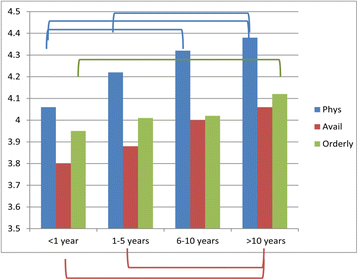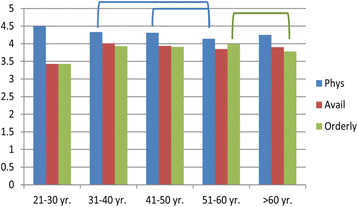Influences on patient satisfaction in healthcare centers: a semi-quantitative study over 5 years
- PMID: 28526039
- PMCID: PMC5438500
- DOI: 10.1186/s12913-017-2307-z
Influences on patient satisfaction in healthcare centers: a semi-quantitative study over 5 years
Abstract
Background: Knowledge of ambulatory patients' satisfaction with clinic visits help improve communication and delivery of healthcare. The goal was to examine patient satisfaction in a primary care setting, identify how selected patient and physician setting and characteristics affected satisfaction, and determine if feedback provided to medical directors over time impacted patient satisfaction.
Methods: A three-phase, semi-quantitative analysis was performed using anonymous, validated patient satisfaction surveys collected from 889 ambulatory outpatients in 6 healthcare centers over 5-years. Patients' responses to 21 questions were analyzed by principal components varimax rotated factor analysis. Three classifiable components emerged: Satisfaction with Physician, Availability/Convenience, and Orderly/Time. To study the effects of several independent variables (location of clinics, patients' and physicians' age, education level and duration at the clinic), data were subjected to multivariate analysis of variance (MANOVA)..
Results: Changes in the healthcare centers over time were not significantly related to patient satisfaction. However, location of the center did affect satisfaction. Urban patients were more satisfied with their physicians than rural, and inner city patients were less satisfied than urban or rural on Availability/Convenience and less satisfied than urban patients on Orderly/Time. How long a patient attended a center most affected satisfaction, with patients attending >10 years more satisfied in all three components than those attending <1-5 years. Level of education affected patients' satisfaction only in the component Orderly/Time; patients without a high school education were significantly less satisfied than those with more. Patients in their 40's were significantly less satisfied in Availability/Convenience than those >60 years old. Patients were significantly more satisfied with their 30-40 year-old physicians compared with those over 60. On Orderly/Time, patients were more satisfied with physicians who were in their 50's than physicians >60.
Conclusions: Improvement in patient satisfaction includes a need for immediate, specific feedback. Although Medical Directors received feedback yearly, we found no significant changes in patient satisfaction over time. Our results suggest that, to increase satisfaction, patients with lower education, those who are sicker, and those who are new to the center likely would benefit from additional high quality interactions with their physicians.
Keywords: Community health; Health care delivery; Patient satisfaction.
Figures






Similar articles
-
A Comparison of Expectations of Physicians and Patients with Chronic Pain for Pain Clinic Visits.Pain Pract. 2017 Mar;17(3):305-311. doi: 10.1111/papr.12428. Epub 2016 Mar 15. Pain Pract. 2017. PMID: 26992011
-
Do 360-degree feedback survey results relate to patient satisfaction measures?Clin Orthop Relat Res. 2015 May;473(5):1590-7. doi: 10.1007/s11999-014-3981-3. Clin Orthop Relat Res. 2015. PMID: 25287521 Free PMC article.
-
Comparison of patient satisfaction with ambulatory visits in competing health care delivery settings in Geneva, Switzerland.J Epidemiol Community Health. 1996 Aug;50(4):463-8. doi: 10.1136/jech.50.4.463. J Epidemiol Community Health. 1996. PMID: 8882233 Free PMC article.
-
Evaluating Factors That Influence Patient Satisfaction in Otolaryngology Clinics.Ann Otol Rhinol Laryngol. 2023 Jan;132(1):19-26. doi: 10.1177/00034894211055531. Epub 2022 Jan 29. Ann Otol Rhinol Laryngol. 2023. PMID: 35094607 Review.
-
Patient satisfaction and experience of primary care in Saudi Arabia: a systematic review.Int J Qual Health Care. 2018 Dec 1;30(10):751-759. doi: 10.1093/intqhc/mzy104. Int J Qual Health Care. 2018. PMID: 29860320
Cited by
-
Patient Satisfaction with Nursing Care in Five Major Departments in a Tertiary Care Centre.JNMA J Nepal Med Assoc. 2019 Sep-Oct;57(219):367-370. doi: 10.31729/jnma.4643. JNMA J Nepal Med Assoc. 2019. PMID: 32329467 Free PMC article.
-
Health insurance in private and public health facilities in Southwestern Nigeria: what determines clients´ satisfaction with quality of service?Pan Afr Med J. 2022 Apr 1;41:268. doi: 10.11604/pamj.2022.41.268.26875. eCollection 2022. Pan Afr Med J. 2022. PMID: 35734315 Free PMC article.
-
Determinants of Asian Students' Medical Satisfaction in China: A Cross-Sectional Survey.J Multidiscip Healthc. 2025 Mar 29;18:1803-1812. doi: 10.2147/JMDH.S514212. eCollection 2025. J Multidiscip Healthc. 2025. PMID: 40176951 Free PMC article.
-
Patient and Staff Satisfaction and Experience While Transforming Health Center Systems.Risk Manag Healthc Policy. 2022 Nov 11;15:2115-2124. doi: 10.2147/RMHP.S375983. eCollection 2022. Risk Manag Healthc Policy. 2022. PMID: 36386560 Free PMC article.
-
Mature Adults at the GP: Length of Visit and Patient Satisfaction-Associations with Patient, Doctor, and Facility Characteristics.Medicina (Kaunas). 2022 Jan 20;58(2):159. doi: 10.3390/medicina58020159. Medicina (Kaunas). 2022. PMID: 35208483 Free PMC article.
References
-
- Burroughs TE, Waterman BM, Gilin D, Adams D, McCollegan J, Cira J. Do on-site patient satisfaction surveys bias results? Jt Comm J Qual Pt Safety. 2005;31(3):158–66. - PubMed
MeSH terms
LinkOut - more resources
Full Text Sources
Other Literature Sources
Medical

